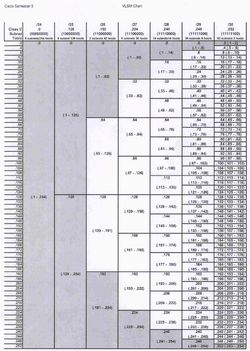
The VLSM subnetting chart
VLSM or variable length subnet masking is the more realistic way of subnetting a network to make for the most efficient use of all of the bits. Remember that when you perform classful subnetting, all subnets have the same number of hosts because they all use the same subnet mask. This leads to inefficiencies. For example, if you borrow 4 bits on a Class C network, you end up with 14 valid subnets of 14 valid hosts. A serial link to another router only needs 2 hosts, but with classical subnetting, you end up wasting 12 of those hosts.
It is for this reason that VLSM is used and to put it simply it is the process of “subnetting a subnet” and using different subnet masks for different networks in your IP plan. What you have to remember is that you need to make sure that there is no overlap in any of the addresses.
The process of VLSM can be split in to 5 simple rules:
- Step 1 - Determine how many H bits will be needed to satisfy the largest network.
- Step 2 - Pick a subnet for the largest network to use.
- Step 3 - Pick the next largest network to work with.
- Step 4 - Pick the third largest network to work with.
- Step 5 - Determine network numbers for serial links.
VLSM calculators can make this process automatic.